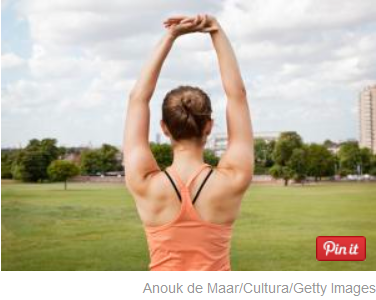Experts often tout back exercise as the best way to manage pain. But many people don’t know where to start. How can you get your back strong without hurting it in the process?
First, get your doctor’s okay to exercise. Also, seeing a licensed physical therapist may get you started exercising in a way that is safe and effective for your back. After that, the key is to approach gently, work at your level of strength and flexibility and choose moves that are known to have beneficial effects on back health.
Here is a beginner’s back exercise routine often given to back pain patients.

1. Arm Overhead Upper Back Stretch and Core Strengthener
This simple movement is more than a stretch. Concentrate on keeping your rib cage stationary as you raise your arms, and you’ll work your upper core muscles.
Lie down on your back. Bend your knees and put your feet flat on the floor. Your arms should be down by your side. Gently reach your fingertips away from your head and slide your shoulders down your back. Try to keep the front of your shoulders wide as you reach.
Lift your arms slowly until they are all the way over (or as far as you can go). As you move your arms, keep the ribs in the same position as they were when you started. This is what will strengthen your core. Bring your arms back down slowly.

Often the first exercise taught to back pain patients in physical therapy, pelvic tilts get your spine moving.
Lie on the floor with your knees bent and feet flat. Initiate the pelvic tilt movement as you exhale. Tilt the bottom of your pelvis toward your head. This part of the action will likely result in a slight rounding of your low back. Next, inhale and tilt the bottom of your pelvis away from your head. This part of the movement most likely will result in a slight back arch.
NOTE: This is not about forcing your back into position. Check your tension as you do the pelvic tilts. Putting too much effort into the action may negate the exercise’s benefits.

The abdominal crunch is just about the most basic stomach exercise you can do.
Lie on your back with your knees bent and feet flat on the floor. Your arms should be straight down by your side. Tuck your chin in toward your neck. Slowly lift your head and shoulders up off the floor. Hold the position – but not your breath – for a slow count of 5.
Slowly reverse what you just did. First, gently bring your upper back down, next your shoulders and finally your head. Keep your stomach pulled in as you lower.
You can cross your arms in front of your body, put your hands behind your head (elbows bent), and/or lift your head and shoulders off the floor for more challenge.

This beginner exercise involves an ab crunch combined with a rotational movement of the shoulder.
Lie on your back. Bend your knees and place your feet flat on the floor. Your arms should be down by your side. Tuck your chin in toward your chest slightly. Inhale, then exhale and curl your head, neck and left shoulder off the floor. Aim your left shoulder toward your right hip bone as you lift. Stay up there for a count of 5. Keep breathing!
Come back down slowly as you exhale. Bring your shoulder back first, then your neck and finally your head.
The obliques enable you to twist and tilt your spine, and they help stabilize the core.

If you are interested in strengthening your back, a key lower back exercise to include in your routine is the abdominal bridge. Here’s how to perform this important core strengthener.
Lie on your back with your knees bent and feet flat on the floor. Your arms should be straight down by your side. They’ll stay that way throughout the exercise. Press your feet into the floor and lift your posterior up. At first, taking your hips high is not as important as doing the exercise with good technique. Stay up for one inhale. Then exhale and lower your body back to the ground.
Repeat several times. Each time, try to go a little higher and stay up a little longer. (Remember to keep breathing!

Core strengthening exercise programs almost always include some type of leg extension work. Leg extension exercises work your abdominals, especially the transverse abdominal, which helps stabilize your back.
Lie on your back. Bend your knees and place your feet flat on the floor. Your arms should be down by your sides at first.
Leaving one foot on the floor, flex the other leg toward your body. Slowly place the bent leg back down on the floor. Repeat with the other leg.
Progress this exercise by lifting the other leg up before you finish placing the bent leg back on the floor. As you get stronger, you can put your hands behind your head with your elbows bent. For even more challenge, lift your head and shoulders off the floor. More »

The quadriped back stretch is done in a hands and knees position. Position yourself on “all fours” with your knees directly under your hips and your wrists directly under your shoulders. Gently alternate between arching your back and rounding it. Coordinate your breathing: When you inhale, arch your spine, and when you exhale, round it.
The quadruped back stretch targets your abdominal and back muscles. More »

In the bird dog exercise, form is paramount. To keep your form, pay attention to your trunk movements. The actions of leg and/or arm lifting may “tempt” your core to waiver. Don’t let it. Keeping good form is what strengthens the core muscles.
Get onto your hands and knees. Inhale and, lift your right arm. Remember, keep your trunk where it is. Exhale, slowly set your arm back down. Repeat with the left arm.
Next, try lifting your right leg as you inhale. Again, keep your trunk steady. Legs are heavier than arms, so this may be more challenging, particularly at the moment your leg first touches the floor. Repeat with the other leg.
The most advanced version of the bird dog is to lift opposite arm and leg at the same time. More »

Repeat this back extension sequence 3-5 times.
9. Prone Press Up For Back Extension
Exercises that take place in the prone position and challenge back muscles may not be for you if you have spinal arthritis or facet joint problems. If you are unsure as to whether exercising in the prone position is right for you, consult your doctor before trying this.
Lie prone and place your forehead on the floor with forearms on the floor beside you.
Exhale and push your trunk up by pressing onto your forearms. Come to rest on your forearms with elbows bent. If you’re strong enough, try pressing all the way up. Hold the position for between 5 to 30 seconds. Slowly lower yourself down to the start position.

Lie on your back. Bend your knees and place your feet flat on the floor, and your arms extended out to the side. Allow your knees to drop gently to your right.
Stay in this position and just breathe. You’ll likely feel the stretch. Enjoy! Turn your head in the other direction and look at your hand. To return to the start position, bring either your head back first, or your hips and legs first. Try to use your pelvis to leverage the weight of your legs, rather than the other way around. This gives you extra strengthening work in your oblique abdominal muscles.
Repeat the back twist 3 to 5 times to start. Over time, you can build up the number of reps you do.
Read the full post in about health










